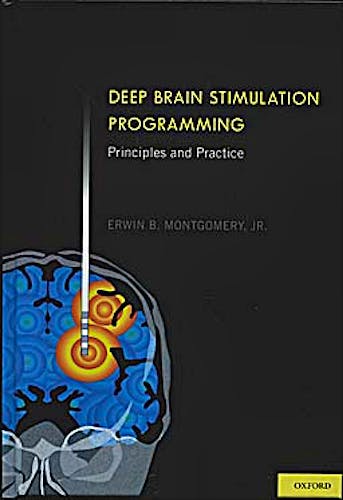

No hay productos en el carrito



Deep Brain Stimulation Programming. Principles and Practice
Montgomery, E.
1ª Edición Abril 2010
Inglés
Tapa dura
180 pags
1200 gr
19 x 26 x 2 cm
ISBN 9780199738526
Editorial OXFORD
LIBRO IMPRESO
-5%
72,00 €68,40 €IVA incluido
69,23 €65,77 €IVA no incluido
Recíbelo en un plazo de
2 - 3 semanas
About this book
- Easily understood principles of electronics, electrophysiology and regional anatomy that provides for a rational approach to effective and efficient post-operative management of Deep Brain Stimulation.
- Helpful tools, logic, and algorithms for DBS management.
- Introduction to the mechanisms of action of DBS particularly related to the neuro- and electrophysiological properties of neurons and neural systems.
- Easily generalized to new DBS indications and uses.
- Introduction to future directions of DBS and brain research using DBS as a probe, particularly with regard to the increasing importance of neural oscillators.
Deep Brain Stimulation (DBS) is a remarkable therapy for an expanding range of neurological and psychiatric disorders. In many cases it is better than best medical therapy and succeeds even when brain transplants fail. Yet despite the remarkable benefits, many physicians and healthcare professionals seem hesitant to embrace this therapy. Post-operative programming of the DBS systems seems unfamiliar, even mysterious, and is viewed as difficult and time consuming. However, DBS programming is rational and can be efficient and effective if one understands the basing underlying concepts of electronics, electrophysiology, and the relevant regional anatomy. Even these principles can be relatively easy to grasp.
The book helps the reader to obtain an intuitive understanding of the basic principles of electronics, electrophysiology and the relevant regional anatomy through the use of readily understood metaphors and numerous illustrations. In addition a number of tools are provided including algorithms to ensure efficient and thorough programming. Forms are provided to help with documentation.
In addition, DBS related research provides a remarkable tool to understand how the brain works and what happens in diseases such as Parkinson's disease. Already long cherished theories of the pathophysiology of Parkinson's disease must be abandoned. Indeed, these DBS derived insights suggest fundamental revisions of theories of brain function are in order. The book provides an introduction to where some of the new theories may lead particularly with the growing awareness of the importance of oscillations in the brain's activities. The brain has more in common with electrical devices, such as computers, than it does to a stew of chemicals. DBS operates at the electrical level in the brain, which is fundamental to how the brain creates, manipulates and conveys information and may indeed be fundamental to the misinformation the results in the dysfunction related to disorders of the brain.
Readership: 1. Neurologists, neurosurgeons, and psychiatrists. 2. Residents in neurology, neurosurgery, and psychiatry. 3. Nurse practitioners, Physician Assistants, and nurses in Neurology, Neurosurgery, and Psychiatry and students in these fields. 4. Biomedical engineers and students. 5. Neuroscientists and students.
Author Information
Erwin B. Montgomery, Jr., MD, Sigmund Rosen MD Scholar in Neurology, Professor of Neurology, Department of Neurology, University of Alabama-Birmingham
© 2025 Axón Librería S.L.
2.149.0